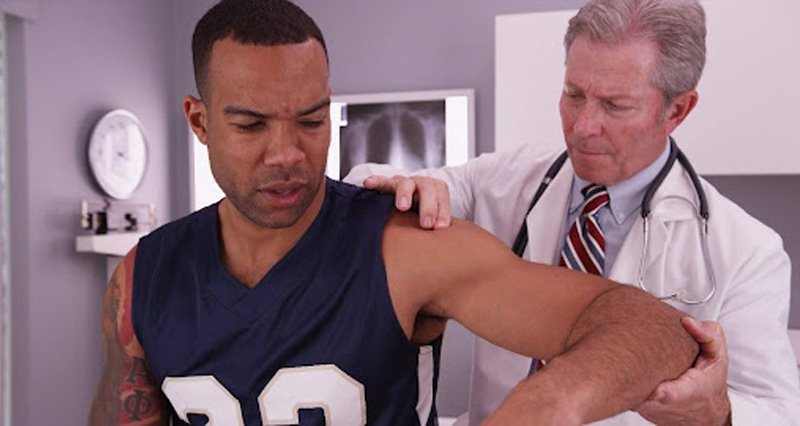CONDITIONS
Shoulder Pain
Overview
Shoulder pain is a common complaint that can significantly impact daily activities and quality of life. Whether it’s a dull ache, sharp twinge, or constant discomfort, shoulder pain can make simple tasks like reaching overhead, lifting objects, or even sleeping difficult. In this blog post, we’ll explore the causes of shoulder pain and how chiropractic care can provide relief and promote overall shoulder health
At Peak Health Chiropractic, we aim to provide precise chiropractic treatments as we get to the root cause of the problem. Aside from reliving the pain, we are committed to keep the pain from relapsing as we address other signs and symptoms along with physical therapy to help strength and stability of your overall spine

Causes of Shoulder pain
Muscle Strains and Sprains – Overuse, repetitive motions, or sudden injuries can cause strains or sprains in the muscles and ligaments surrounding the shoulder joint, leading to pain and discomfort
Rotator Cuff Injuries – The rotator cuff is a group of muscles and tendons (tendonitis) that stabilise the shoulder joint. Injuries such as tears or strains in the rotator cuff can cause pain and limited mobility.
Frozen Shoulder – Also known as adhesive capsulitis, frozen shoulder is characterised by stiffness and pain in the shoulder joint, often resulting from inflammation and tightening of the joint capsule.
Shoulder Impingement – This occurs when the tendons of the rotator cuff become pinched or compressed between the bones of the shoulder, causing pain and inflammation.
Scapular dyskinesia – This condition is presented in faulty movements of shoulder blade rhythm, typically caused by unnatural & repetitive movement of fall on outstretch arm (FOOSH)
Osteoarthritis – Degenerative changes in the shoulder joint can lead to osteoarthritis, resulting in pain, stiffness, and reduced range of motion
Neck subluxations. Commonly seen conditions such as scoliosis, abnormal curvature presented in the spine such as muscle imbalances or postural dysfunction. You may have neck problem if pain radiates to your shoulder blade or close to the side of your neck. Electric-like, stabbing, burning or tingling, radiates down past your elbow or even into your hand and persists at rest. Radiates down your arm when you extend or twist your neck
Other causes:
Bursitis: Inflammation and swelling between the top of the arm bone and the tip of the shoulder.
Dislocated shoulder: Upper arm bone pops out of the shoulder socket.
Fracture: Broken bones of the shoulder commonly occur after a fall in elderly patients or an injury in younger patients typically the AC joint that is not uniformly healed

Symptoms of Shoulder Pain
Pain and Discomfort: The most obvious symptom of shoulder pain is discomfort in or around the shoulder joint. This pain can range from a dull ache to sharp, stabbing sensations and may be present both at rest and during movement.
- Limited Range of Motion: Individuals with shoulder pain often experience difficulty moving their arm freely. This can manifest as reduced ability to raise the arm overhead, reach behind the back, or perform other basic movements without discomfort or stiffness.
- Stiffness and Tightness: Tightness and stiffness in the shoulder joint and surrounding muscles are common symptoms of shoulder pain. This sensation can make it challenging to perform everyday activities and may worsen over time if left untreated.
- Weakness: Weakness in the shoulder muscles may accompany shoulder pain, making it challenging to perform tasks that require strength, such as lifting objects or pushing/pulling movements.
- Swelling and Inflammation: Inflammatory conditions like bursitis or tendonitis can cause swelling, redness, and warmth in the shoulder area. Swelling may be visible or palpable, and it often exacerbates pain and discomfort.
- Popping or Clicking Sensations: Some individuals with shoulder pain report audible or palpable sensations of popping, clicking, or grinding when moving the shoulder joint. These noises may indicate underlying issues such as joint instability or cartilage damage.
- Radiating Pain: Shoulder pain can radiate to other areas of the body, such as the neck, upper back, arm, or even the chest. This radiating pain may be indicative of nerve compression or referred pain from underlying musculoskeletal conditions.

How can Chiropractic care help with shoulder pain?
After understanding your health history and performing examinations, the Doctor of Chiropractic(DC) will be able to identify what is the primary cause of your shoulder issue and then we can put together a care-plan that suit your condition and goals.
Under regular chiropractic care, the aim is to correct the underlying causes of your shoulder dysfunction as well as other spinal injury. Chiropractic care uses specific adjustments to help improve shoulder or scapular dysfunction & spinal function
Prognosis (each case is different)
The main factors for shoulder pain to improve is dependent on the mechanism of injury. Other factors such as your age, duration of your shoulder pain, other signs and symptoms you have neglected for example your posture, muscle imbalances, joint tightening and blocking over a period of time and the severity shown on your spinal x-rays are factors that can slow down your improvements
Lifestyle components to gauge your progress would depend on your general health and well being, your exercise habits (under, over or improper exercising movements), your level of commitment towards your recommended care-plan by the Doctor of Chiropractic(DC)

